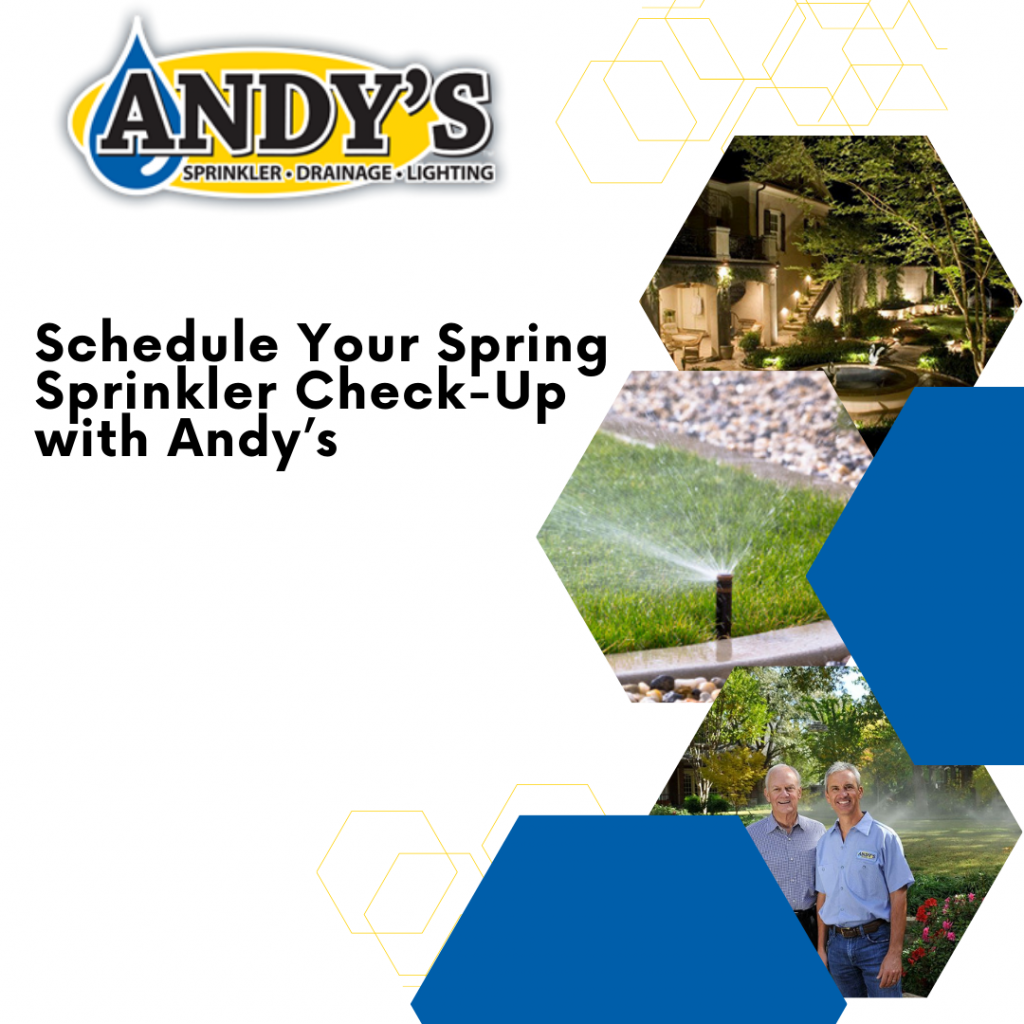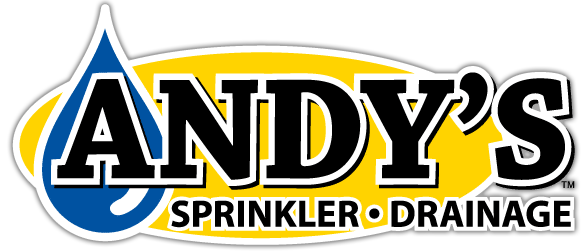
Schedule Your Spring Sprinkler Check-Up with Andy’s
Spring Sprinkler Check-Up - As the days grow longer and temperatures begin to rise, it's time to start preparing your landscape for the bountiful spring season. The health and beauty of your lawn and garden heavily depend on the efficiency and proper functioning of your sprinkler system. Make sure you're ready for the growing season by scheduling a sprinkler system check-up with the experts at Andy's.
At Andy's, their team of technicians specializes in installing and repairing sprinkler systems, drainage systems, and outdoor lighting. They understand the importance of keeping your irrigation components in top-notch condition to ensure a healthy, water-efficient landscape. By giving your sprinkler system the professional attention it deserves, you'll not only save money on your water bill but also contribute to the conservation of our precious water resources.
In this comprehensive guide, we'll dive deep into the essential steps to ensure your sprinkler system is prepared for the spring season. We'll cover routine maintenance tasks, upgrading to smart irrigation systems, proper landscape practices, and the benefits of partnering with professional irrigation experts like Andy's. By following these best practices, you'll be well on your way to a lush, vibrant landscape that's ready for the warm months ahead.
Assessing Your Sprinkler System for Winter Damage
One of the first and most important steps in preparing your sprinkler system for spring is assessing any potential damage that may have occurred during the winter months. Cold temperatures and freezing conditions can cause damage to various components of your irrigation system. Identifying any issues early on will ensure that your sprinkler system is fully operational and efficient when it's time to begin watering your landscape in the spring. Here are a few common signs of winter damage to look for:
- Cracked Pipes and Valves: Freezing and thawing ground conditions can cause pipes and valves to crack. Inspect your sprinkler system components for any visible damage, and repair or replace them as needed.
- Damaged Sprinkler Heads: Look for broken or cracked sprinkler heads. Over time, debris may accumulate within the sprinkler head nozzles, affecting their performance and efficiency. Clean and inspect the heads or replace them if necessary.
- Controller Failures: Ensure your irrigation system's controller is functioning properly. Cold temperatures can cause the controller to malfunction or fail entirely. Replace any damaged components or consult with a professional if you're uncertain about the controller's functionality.
Optimizing Your Sprinkler System for Spring Efficiency
Once you have addressed any potential winter damage, it's time to optimize your sprinkler system for spring efficiency. This means ensuring that your system is adjusted to deliver the right amount of water to your landscape at the most appropriate times. Take the following steps to optimize your sprinkler system:
- Adjust Sprinkler Heads: Make sure that each sprinkler head is adjusted so that it covers the intended area without overspray. Avoid watering sidewalks, driveways, or other impervious surfaces to conserve water and save on your water bill.
- Update Watering Schedule: As temperatures rise and plants enter their growing season, it's essential to adjust your watering schedule accordingly. Monitor local weather conditions, and increase your watering frequency if necessary. Be sure to follow any local watering restrictions or guidelines.
- Perform a System Audit: Conduct a system audit to determine if your sprinkler system is running at peak efficiency. A system audit measures the rate at which water is being applied and ensures even distribution across your landscape. You may need to adjust your sprinkler heads, replace worn nozzles, or repair broken pipes to maintain optimal performance.
Upgrading to a Smart Irrigation System for Improved Water Usage
Investing in a smart irrigation system can significantly improve your sprinkler system's efficiency and reduce water waste. These advanced systems allow for more precise watering schedules, save money on your water bill, and promote an eco-friendly, water-wise landscape. Here are some features to consider when upgrading to a smart irrigation system:
- Weather-Based Controllers: Weather-based irrigation controllers, also known as "smart controllers," automatically adjust your watering schedule based on real-time weather data. This means that your irrigation system will provide the optimal amount of water for your plants based on current weather conditions, helping to conserve water and maintain a healthy landscape.
- Soil Moisture Sensors: Soil moisture sensors measure the amount of water in the soil and communicate this information to your irrigation controller. This allows your system to adjust watering schedules based on actual soil moisture levels, ensuring that your plants receive the proper amount of water without over- or under-watering.
- High-Efficiency Nozzles and Drip Irrigation: Upgrading to high-efficiency sprinkler nozzles or drip irrigation can dramatically reduce water waste by delivering water more directly to your plants' root systems. This prevents water loss from evaporation and runoff, allowing your landscape to receive optimal hydration with minimal water waste.
Maintaining Proper Drainage Systems to Support a Healthy Landscape
A well-functioning drainage system is essential for maintaining a healthy landscape during the spring growing season. Good drainage prevents waterlogging, protects plants from overwatering and root diseases, and reduces soil erosion. Here are some steps to ensure your landscape's drainage system is in top condition:
- Inspect and Clean Drainage Components: Examine your drainage system regularly, including French drains, catch basins, and other components, for any blockages or damage. Remove debris and make repairs as necessary to facilitate proper water flow.
- Check Downspout Extensions: Ensure that the downspout extensions are correctly connected to your gutter system and are directing water away from your home and landscape. This will prevent water from pooling near your home's foundation or causing erosion issues in your landscape.
- Monitor Slopes and Runoff: Observe your landscape during rain events to identify any areas where water is pooling or causing excessive runoff. If needed, consider installing additional drainage measures to prevent water damage and promote healthy plant growth.
Incorporating Water-Saving Landscaping Techniques
In addition to optimizing your sprinkler system, implementing water-saving landscaping techniques can further support water efficiency and maintain a healthy, vibrant landscape. Consider the following strategies to save water and money while enhancing your outdoor spaces:
- Mulch and Compost: Applying a layer of mulch or compost around your plants can help retain moisture in the soil, reducing the need for frequent watering. Mulch also suppresses the growth of weeds, which compete with your plants for water and nutrients.
- Group Plants with Similar Water Needs: Creating planting zones with plants that have similar water requirements can make it easier to adjust your irrigation system for different sections of your landscape. This approach ensures that plants receive just the right amount of water without wasting resources.
- Choose Drought-Tolerant Plants: Selecting plants that are native to your region or have low water requirements can significantly reduce your overall landscape water consumption. These plants are well-adapted to local conditions, making them more resilient to fluctuations in temperature and moisture levels.
The Importance of Regular Maintenance for Your Sprinkler System
Proactive and regular maintenance can dramatically extend the life of your sprinkler system, ensuring it continues to function efficiently and provide the necessary water for your landscape. Consider these routine maintenance tasks to enjoy the benefits of a properly functioning sprinkler system:
- Inspect and Clean Sprinkler Heads: Regularly check your sprinkler heads for debris and clean them as needed. Remove any dirt, grass clippings, or other obstacles that may obstruct the spray pattern or impede water flow.
- Check for Leaks: Inspect your sprinkler system for leaks or damaged components at least once per season. Promptly repair any issues to prevent water waste, maintain system efficiency, and avoid potential damage to your landscape.
- Update Watering Schedule: Adjust your watering schedule throughout the year to accommodate changes in temperature, rainfall patterns, and plant growth. This ensures that your landscape receives the appropriate amount of water and minimizes water waste.
Benefits of Seeking Professional Assistance for Your Irrigation System
While some maintenance tasks can be performed by homeowners themselves, seeking the expertise of professional irrigation technicians like the team at Andy's can vastly improve your sprinkler system's performance and efficiency. Here are some benefits of professional assistance:
- Expert Knowledge: Professional irrigation technicians possess extensive knowledge of irrigation system components, functionality, and best practices. They can identify and resolve issues that may be overlooked by homeowners, ensuring that your sprinkler system is fully operational and optimized for your unique landscape needs.
- Cost Savings: Regularly maintaining your sprinkler system with the help of professionals can help save you money on water bills and future repairs. Well-maintained systems are less likely to experience leaks, malfunctions, or other costly issues.
- Access to Advanced Technology: Irrigation professionals stay up-to-date on emerging technologies and can make recommendations on system upgrades that save water and improve overall performance. They can install and calibrate advanced irrigation components, such as smart controllers and soil moisture sensors, to maximize your system's efficiency.
Preparing Your Sprinkler System for Winter: Steps to Prevent Future Damage
Winterizing your irrigation system is a crucial part of its maintenance. When water freezes, it expands, and this expansion can cause significant damage to your irrigation system's pipes and components. If you don't properly winterize your system, you could end up with costly repairs come spring.
One critical step in winterizing your irrigation system is to inspect it thoroughly for any damages. Look out for leaks, broken sprinkler heads, or damaged pipes. If you find any issues, it is crucial to have these fixed immediately. Leaving them unattended can result in water seeping into the system and freezing during the winter, expanding and causing further damage.
If you're unsure about any step of the winterization process, don't hesitate to call a professional like the team at Andy’s. A professional will have the knowledge and experience to thoroughly inspect and prepare your irrigation system for winter. They can also provide you with tips on maintaining your irrigation system throughout the winter months.
The Value of Regular Inspections and System Upgrades
Staying proactive about your sprinkler system's health and efficiency can save you time, money, and stress in the long run. Regular inspections and timely system upgrades not only ensure optimal system performance but also provide opportunities for improvement and enhancement. Here are some tips on maintaining a modern, efficient irrigation system:
- Schedule Regular Inspections: Aim to schedule professional inspections of your sprinkler system at least once or twice a year. A thorough inspection can identify any system inefficiencies, damage, or other issues that need to be addressed in a timely manner.
- Stay Informed About Emerging Technologies: Stay up-to-date on new developments and technologies in the irrigation industry. This can help you to make informed decisions about upgrades that can improve your system's efficiency and reduce your environmental footprint.
- Replace Aging Components: As sprinkler system components age, their efficiency often declines, and the risk of damage or failure increases. Proactively replacing older components before they become significant problems can save you time and money in the long run.
Embrace a Sustainable Approach to Landscape Irrigation and Outdoor Lighting
Implementing water-saving landscaping techniques, optimizing your irrigation system, incorporating eco-friendly practices, and enhancing your outdoor spaces with energy-efficient lighting are excellent ways to create a sustainable, beautiful, and thriving landscape. By carefully planning and maintaining your sprinkler system, you can dramatically improve its efficiency, save water, and reduce costs.
Andy's is your trusted partner in ensuring your landscape irrigation and outdoor lighting systems are designed, installed, and maintained to provide maximum performance and aesthetic appeal. Their experienced team of professionals can help you achieve the perfect balance between water efficiency, landscape health, and outdoor enjoyment. Whether you need assistance with system maintenance, and upgrades, or seeking advice on the latest trending technologies, Andy's is committed to meeting your unique needs and exceeding your expectations. Reach out to Andy’s today for expert sprinkler system services.
Interested in working with us? Check Carrers
